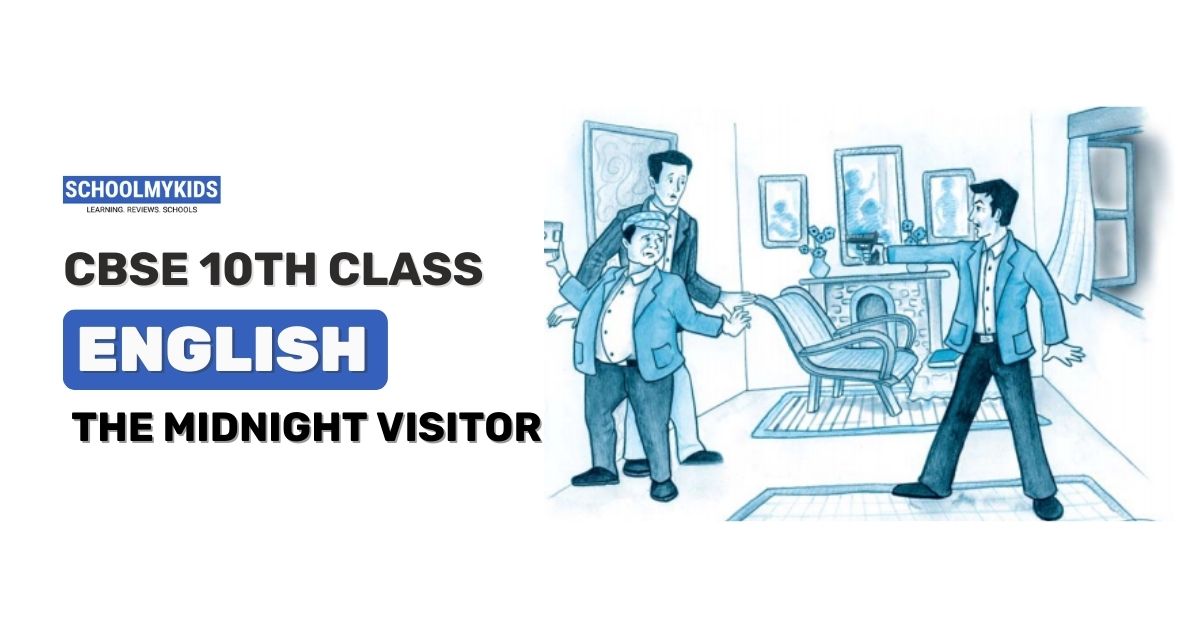“The Midnight Visitor” is a chapter from the Class 10 CBSE English textbook, “Footprints without Feet”
Summary
“The Midnight Visitor” is an intriguing story by Robert Arthur, included in the CBSE 10th board English syllabus. The narrative revolves around Ausable, a secret agent, and his unexpected encounter with an intruder in his hotel room. Ausable is described as a clever and resourceful agent, though he doesn’t fit the typical image of a spy. He is short, fat, and speaks with an American accent, which often leads others to underestimate him.
One night, Ausable returns to his hotel room with a writer named Fowler, who is eager to see some real-life espionage action. To Fowler’s surprise, they find a man named Max waiting for them with a gun. Max, a rival spy, demands some important papers concerning missiles that Ausable is expected to receive. Despite the dangerous situation, Ausable remains calm and starts weaving a story about a balcony outside the window, which he claims is used for entering and leaving the room without being noticed.
Ausable’s quick thinking and composed demeanor confuse Max. Just as Max begins to believe the story about the balcony, there is a knock at the door. Ausable claims it must be the police he had requested for extra security. Panicked, Max jumps out of the window to escape the imaginary police, only to realize too late that there is no balcony, and he falls to his demise. The knock at the door turns out to be a waiter bringing Ausable’s ordered drinks.
Analysis
“The Midnight Visitor” is a captivating story that highlights the importance of wit, quick thinking, and composure in high-pressure situations. The story provides an excellent commentary on how appearances can be deceiving and emphasizes the value of intellect over physical prowess.
The central theme of the story revolves around the triumph of intelligence and resourcefulness over brute force. Ausable’s character defies the stereotypical image of a secret agent, showing that true strength lies in one’s ability to think and act swiftly in the face of danger.
Robert Arthur uses a mix of suspense and humor to keep readers engaged. The story’s setting—a seemingly ordinary hotel room—adds to the surprise and tension, demonstrating that dramatic events can occur in the most mundane places. Arthur’s portrayal of Ausable’s calm and collected nature under threat contrasts sharply with Max’s aggressive yet ultimately foolish behavior.
The narrative also explores the theme of deception. Ausable’s fabricated story about the balcony and the supposed arrival of the police play on Max’s fears and assumptions, leading to his downfall. This highlights how easily people can be manipulated when they fail to question what they are told.
Important Questions with Explanations
- What is the central theme of “The Midnight Visitor”?
- The central theme is the triumph of intelligence and resourcefulness over physical force and aggression. It highlights the importance of wit and quick thinking.
- Describe Ausable’s character in the story.
- Ausable is a clever, resourceful, and composed secret agent. Despite not fitting the typical image of a spy, his quick thinking and calm demeanor help him outwit his adversary.
- How does Ausable outwit Max?
- Ausable outwits Max by fabricating a story about a balcony outside the window and claiming that the police are on their way, causing Max to panic and jump out the window.
- What role does Fowler play in the story?
- Fowler is a writer who accompanies Ausable, hoping to see some real-life espionage action. His presence helps highlight Ausable’s intelligence and resourcefulness.
- How does the setting contribute to the story’s suspense?
- The ordinary setting of a hotel room adds to the suspense as it contrasts with the high-stakes espionage scenario, making the unfolding events more surprising and tense.
- What does Max’s character represent in the story?
- Max represents the stereotypical aggressive and overconfident spy who relies on force. His failure highlights the story’s theme that intelligence and composure are more effective.
- Explain the significance of the story’s title, “The Midnight Visitor”.
- The title refers to Max, the unexpected intruder who arrives at midnight. It sets the tone for the suspenseful and unexpected events that follow.
- What message does the story convey about appearances?
- The story conveys that appearances can be deceiving. Ausable, who does not look like a typical spy, proves to be highly intelligent and resourceful, contrary to initial impressions.
- How does Robert Arthur use humor in the story?
- Arthur uses humor through Ausable’s witty remarks and the ironic twist of the waiter’s arrival, which adds a lighthearted element to the tense situation.
- What lesson does Max learn in the story?
- Max learns, albeit too late, that underestimating others and acting on assumptions without verifying information can lead to disastrous consequences.
- Analyze the role of deception in “The Midnight Visitor”.
- Deception plays a crucial role as Ausable’s fabricated story about the balcony and the police effectively manipulates Max, leading to his downfall.
- How does the story challenge the stereotypical image of a spy?
- The story challenges the stereotypical image by portraying Ausable, a seemingly unremarkable man, as a highly competent and intelligent secret agent.
- Discuss the significance of the waiter’s arrival in the story.
- The waiter’s arrival, mistaken for the police, heightens the suspense and leads to the climax where Max’s panic results in his fatal mistake.
- What does the balcony symbolize in the story?
- The balcony symbolizes the power of imagination and deception. It is a fictional element that becomes crucial in outsmarting Max.
- How does Fowler’s perception of Ausable change throughout the story?
- Fowler’s perception changes from seeing Ausable as an unimpressive agent to recognizing his cleverness and ability to handle dangerous situations effectively.
- What is the impact of the story’s climax on the reader?
- The climax surprises the reader, emphasizing the story’s themes and showcasing Ausable’s ingenuity, leaving a lasting impression about the value of intelligence over brute force.
- Explain how Ausable’s calm demeanor influences the outcome of the story.
- Ausable’s calm demeanor keeps the situation under control, allowing him to manipulate Max’s fears and ultimately lead him into making a fatal error.
- What does the story reveal about human nature and fear?
- The story reveals that fear can cloud judgment and lead to irrational decisions. Max’s fear of the police blinds him to the reality, leading to his demise.
- How does the story exemplify the use of quick thinking in crisis situations?
- The story exemplifies quick thinking through Ausable’s immediate creation of a plausible story to confuse Max and gain the upper hand.
- What overall message does “The Midnight Visitor” convey?
- The overall message is that intelligence, resourcefulness, and composure are powerful tools that can outmatch physical force and aggression in overcoming challenges.
Conclusion
“The Midnight Visitor” by Robert Arthur is an engaging and suspenseful story that underscores the importance of wit and intelligence in overcoming adversity. Through the clever and resourceful character of Ausable, the story challenges stereotypes and highlights the power of quick thinking and composure. For students preparing for the CBSE 10th board English exam, understanding this story provides valuable insights into character development, thematic exploration, and narrative techniques, enriching their literary knowledge and analytical skills.









Be the first one to comment on this story.